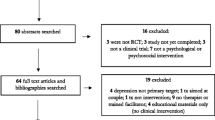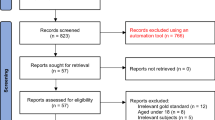Abstract
Background
Prior studies providing estimates of the prevalence of postnatal depressive symptoms (PNDS) in New Zealand have been hampered by methodological shortcomings. Aims of this study were to derive an accurate estimate of PNDS prevalence and treatment frequency in an urban population of a major city in New Zealand.
Method
This was a one-wave postal survey of a probability, community sample of all women in Auckland who were 4 months postpartum. PNDS was assessed with the Edinburgh Postnatal Depression Scale (EPDS).
Results
There were 225 usable responses (78% response-rate): 36 women (16.0%) scored above the threshold for depressive symptomatology, and nine of them were in treatment. A further 31 women (13.8%) scored just below the threshold region for depressive symptomatology, and none were in treatment.
Conclusion
The prevalence rate of PNDS in urban New Zealand is slightly higher than the world-wide average, and goes largely untreated in the community. Health care providers should remain vigilant to the finding that almost one in three mothers with infants is suffering with symptoms of depression and may need strong encouragement to admit they need help.
Similar content being viewed by others
References
Cicchetti D, Rogosch FA, Toth SL (1998) Maternal depressive disorder and contextual risk: contributions to the development of attachment insecurity and behavior problems in toddlerhood. Dev Psychopathol 10:283–300
Sharp D, Hale DF, Pawlby S, Schmuecker G, Allen H, Kumar R (1995) The impact of postnatal depression on boys’ intellectual development. J Child Psychol Psychiatr 36:1315–1336
Margaret LM, Heycock EG, Hanna M, Jones PW, Cox JL (2004) Postnatal depression and faltering growth: a community study. Pediatr Rev 113:1242–1248
Mitchell EA, Thompson JM, Stewart AW, Webster ML, Taylor BJ, Hassall IB, Ford RP, Allen EM, Scragg R, Becroft DM (1992) Postnatal depression and SIDS: a prospective study. J Paediatr Child Health 28:S13–S16
Sanderson J, Cowden B, Hall DMB, Taylor EM, Carpenter RG, Cox JL (2002) Is postnatal depression a risk factor for sudden infant death? Br J Gen Pract 52:636–640
Angst J (1998) Treated vs untreated major depressive episode. Psychopathology 31:37–44
Romans-Clarkson SE, Walton VA, Dons DJ, Mullen PE (1991) Which women seek help for their psychiatric problems? NZ Med J 104:7–8
Wells JE, Bushnell JA, Hornblow AR, Joyce PR, Oakley Browne MA (1989) Christchurch psychiatric epidemiology study, part 1: methodology and lifetime prevalence for specific psychiatric disorders. Aust NZ J Psychiatr 23:315–326
Oakley Browne MA, Joyce PR, Wells JE, Bushnell J, Hornblow AR (1989) Christchurch psychiatric epidemiology study, part II. Six month and other period prevalencies of specific psychiatric disorders. Aust NZ J Psychiatr 23:327–340
Cox JL, Holden JM, Sagovsky R (1987) Detection of postnatal depression: development of the 10-item Edinburgh postnatal depression scale. Br J Psychiatr 150:782–786
McGill H, Burrows VLB, Holland LA, Langer HJ, Sweet MA (1995) Postnatal depression: a Christchurch study. NZ Med J 108:162–165
Webster ML, Thompson JMD, Mitchell EA, Werry JS (1994) Postnatal depression in a community cohort. Aust NZ J Psychiatr 28:42–49
Cooper PJ, Campbell EA, Day A (1988) Non-psychotic disorder after childbirth: a prospective study of prevalence, incidence, course and nature. Br J Psychiatr 152:799–806
Health Research Council (1998) Guidelines for researchers on health research involving Maori. Health Research Council, Auckland
Henare M (1996) Christianity: Maori Churches. Chap. 9. In: Donovan P (ed) Religions of New Zealanders, 2nd edn. Dunmore Press, Palmerston N., New Zealand
Tawhai TP (1996) Aotearoa’s Spiritual Heritage. Chap. 1. In: Donovan P (ed) Religions of New Zealanders, 2nd edn. Dunmore Press, Palmerston N., New Zealand
Ovretveit J (1996) The Kiwi way: lessons from New Zealand. Br Med J 312:645
Kish L (1965, 1995) Survey sampling. Wiley-Interscience, New York
Cox JL (1994) Origins and development of the 10-item Edinburgh postnatal depression scale. In: Cox JL, Holden J (eds) Perinatal psychiatry. Use and misuse of the Edinburgh postnatal depression scale. Gaskell, London
Boyce P, Stubbs J, Todd A (1993) The Edinburgh postnatal depression scale: validation for an Australian sample. Aust NZ J Psychiatr 27:472–476
Harris B, Othman S, Davies JA (1992) Association between post partum thyroid dysfunction and thyroid antibodies and depression. Br Med J 305:152–156
SPSS Inc. (1999) SPSS Base 10.0. SPSS Inc., Chicago
Tabachnick BG, Fidell LS (1996) Using multivariate statistics. HarperCollinsCollege, New York
Johnston R (1983) A revision of socio-economic indices for New Zealand, Parts 1 & 2. New Zealand Council for Educational Research, Wellington
Altman DG, Machin D, Bryant TN, Gardner MJ (2000) Statistics with confidence. Confidence intervals and statistical guidelines, 2nd edn. British Medical Journal, Bristol
O’Hara MW, Swain AM (1996) Rates and risk of postpartum depression—a meta-analysis. Int Rev Psychiatr 8:37–54
Wells JE, Robins LN, Bushnell JA, Oakley Browne MA (1994) Perceived barriers to care in St. Louis (USA) and Christchurch (NZ): reasons for not seeking professional help for psychological distress. Soc Psychiat Psychiatr Epidemiol 29:155–164
Cooper PJ, Murray L (1995) Course and recurrence of postnatal depression. Evidence for the specificity of the diagnostic concept. Br J Psychiatry 166:191–195
Romans-Clarkson SE, Walton VA, Herbison GP, Mullen PE (1988) Marriage, motherhood and psychiatric morbidity in New Zealand. Psychol Med 18:983–990
Stein A, Gath DH, Bucher J, Bond A, Cooper P (1991) The relationship between postnatal depression and mother–child interaction. Br J Psychiatry 158:46–52
Coverdale JH, McCullough LB, Chervenak FA, Bayer T (1996) Clinical implications and management strategies when depression occurs during pregnancy. Aust NZ J Obstet Gynaecol 36:424–429
Stowe ZN, Hostetter AL, Newport DJ (2005) The onset of postpartum depression: implications for clinical screening in obstetrical and primary care. Am J Obstet Gynecol 192:522–526
Holden J (1994) Using the Edinburgh postnatal depression scale in clinical practice. In: Cox JL, Holden J (eds) Perinatal psychiatry. Use and misuse of the Edinburgh postnatal depression scale. Gaskell, London
Lee C (1997) Social context, depression, and the transition to motherhood. Br J Health Psychol 2:93–108
Oberman Y, Josselson R (1996) Matrix of tensions: a model of mothering. Psychol Women Quart 20:341–359
Davies B, Welch D (1986) Motherhood and feminism: are they compatible? The ambivalence of mothering. Aust NZ J Sociol 22:411–426
Acknowledgments
This work was undertaken while the first author was a doctoral candidate at the University of Auckland. It would not have been possible without the many health professionals who contributed to the study and the hundreds of mothers who agreed to participate. We also gratefully acknowledge the assistance of Professors Robert Kydd, Timothy Elliott, and Kyle Siegrist.
Author information
Authors and Affiliations
Corresponding author
Rights and permissions
About this article
Cite this article
Thio, I.M., Browne, M.A.O., Coverdale, J.H. et al. Postnatal depressive symptoms go largely untreated. Soc Psychiat Epidemiol 41, 814–818 (2006). https://doi.org/10.1007/s00127-006-0095-6
Accepted:
Published:
Issue Date:
DOI: https://doi.org/10.1007/s00127-006-0095-6




